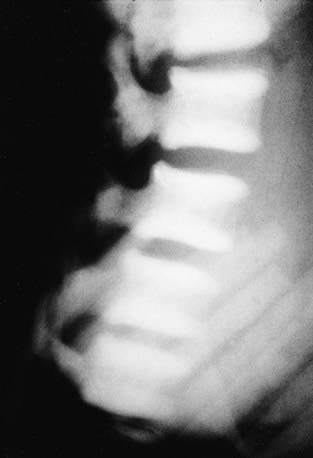Chapter 690 Disorders Involving Defective Bone Resorption
Osteopetrosis
The severe form is usually detected in infancy or earlier because of macrocephaly, hepatosplenomegaly, deafness, blindness, and severe anemia. Radiographs reveal diffuse bone sclerosis. Later films show the characteristic bone-within-bone appearance (Fig. 690-1). With time, infants typically fail to thrive and show psychomotor delay and worsening of cranial neuropathies and anemia. Dental problems, osteomyelitis of the mandible, and pathologic fractures are common. The most severely affected patients die during infancy; less severely affected patients rarely survive beyond the 2nd decade. Those who survive beyond infancy usually have learning disorders but might have normal intelligence despite hearing and vision loss.

Figure 690-1 Lateral radiograph showing bone-in-bone appearance that is characteristic of osteopetrosis.
Pyknodysostosis
Skeletal radiographs show a generalized increase in bone density. In contrast to many disorders in this group, the metaphyses are normal. Other changes include wide sutures and wormian bones in the skull, a small mandible, and hypoplasia of the distal phalanges (Fig. 690-2).
Askmyr MK, Fasth A, Richter J. Towards a better understanding and new therapeutics of osteopetrosis. Br J Haematol. 2008;140:597-609.
Charles JM, Key LL. Developmental spectrum of children with congenital osteopetrosis. J Pediatr. 1998;132:371-374.
de Vernejoul MC. Sclerosing bone disorders. Best Pract Res Clin Rheumatol. 2008;22:71-83.
Gelb BD, Shi GP, Chapman HA, et al. Pycnodysostosis, a lysosomal disease caused by cathepsin K deficiency. Science. 1996;273:1236-1238.
Stark Z, Savarirayan R. Osteopetrosis. Orphanet J Rare Dis. 2009;4:5.
Tolar J, Teitelbaum SL, Orchard PJ. Osteopetrosis. N Engl J Med. 2004;351:2839-2849.





